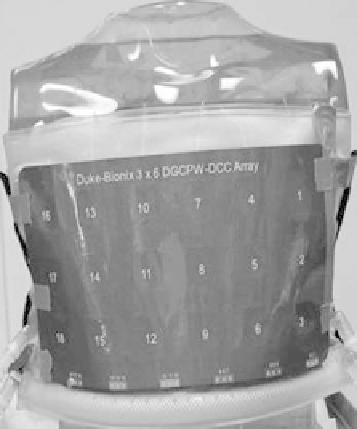Biomedical Engineering Reference
In-Depth Information
aperture size of the whole CFMA-12 is 20.8 × 30 cm
2
. he aper-
ture size of one single antenna element is 6.4 × 7. 0 c m
2
. The small
dimensions are achieved due to the relatively high magnitude of
the lumped inductance, which can be varied in wide limits. Each
mini-antenna of the CFMA-12 array operates in the same way
as the single element CFMA. The CFMA-12 antenna elements
are close to the skin surface, hence a large Ez-component of the
electric field may cause preferential fat heating.
Advantages: flexible substrate; quick and easy to apply to
the treatment region; integrated water bolus;
applicator size does not compromise its use;
comfortable; CFMA-12 spatial power control;
high RF-power output possible.
Disadvantages: single element CFMA: no power control;
bending affects SAR pattern, effective heat-
ing depth increases and decreases for bent
applicator with very local variations; SAR
distribution is not similar for all applica-
tors; resonance effect in water bolus; CFMA-
12 substantial variation in power efficiency
between single elements.
providing a maximum heating depth of 1-2 cm for the DCC
array applicators.
In a very recent review on conformal microwave array
applicators for hyperthermia of diffuse chest wall recurrences,
Stauffer et al. reported the development of a “hyperthermia-
vest” applicator consisting of up to 35 DCC elements [59]. At
present this is the largest applicator available that is lightweight
and sufficiently flexible to follow the contour of the large tumor
spread along the chest wall. Moreover, by integrating a water
bolus and thermal mapping catheters in the applicator design
an important step has been made to improve comfort by rapid
and accurate application to the patient's body (see Figure 8.7).
8.5.1.1.4 Dual Concentric Conductor
The dual concentric conductor (DCC) applicator was developed
during the 1990s to specifically address the clinical demands for
a flexible device that could uniformly heat large area superficial
disease overlying complex contoured anatomy. In its most basic
design the DCC applicator consists of square dual concentric
conductor apertures etched from the front copper surface of
double-sided flexible PCB material [56,57]. Each square element
of the array has an aperture side of 4 cm and is separated from
the 3 cm central patch by a 5 mm radiating gap. The DCC origi-
nally operated at a frequency of 915 MHz, the ISM frequency
band for medical purposes in the United States, but later an
additional DCC design was presented that operates at 433 MHz.
Detailed investigation of the electrical field (x,y,z) components is
highly relevant to fully analyze the near-field characteristics of
a microstrip applicator. Due to the close proximity of the reso-
nant patch to ground electrode, often a strong electrical field
(z-component) perpendicular to the face of the applicator exists.
A strong E
z
component gives rise to a high SAR in the super-
ficial tissues directly in front of the applicator. For the DCC,
clinically desirable uniformity and penetration of SAR can be
obtained for square apertures in the range of 4-6 cm per side
at 433 MHz, using 9.5-12.5 mm thick water coupling boluses,
as compared to the optimum 2-4.5 cm square apertures and
5-10 mm water bolus dimensions determined previously for
915 MHz arrays. With an accompanying reduction in the lateral
adjustability of power control, the 433 MHz applicators can pro-
vide a significantly larger heating area than arrays with the same
number of elements driven at a frequency of 915 MHz [58]. From
theoretical comparison between DCCs operating at 915 and
433 MHz, it is concluded that the penetration depth is similar
for optimally sized apertures at both frequencies of operation,
(a)
(b)
FIGURE 8.7
Conformal Microwave Array applicator. (a) Photo
of 18-element dual concentric conductor array coupled with 9 mm-
thick water bolus to a torso phantom. (b) 18-element DCC array car-
ried by patient and kept at its position by an elastic outer support vest.
(From Stauffer, P.R., Maccarini, P., Arunachalam, K., Craciunescu, P.,
Diederich, C., Juang et al.,
Int J
Hyperthermia
26, 2010.)


